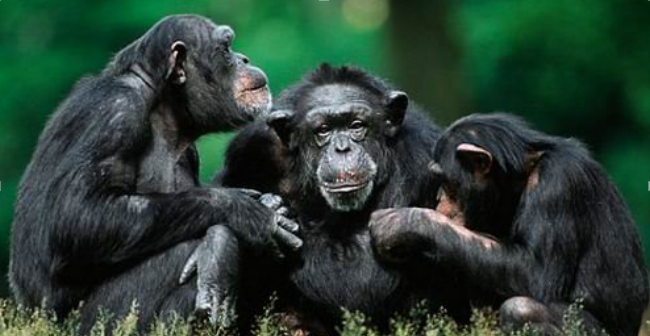
The greater strength of chimpanzees, relative to humans, may have been explained by American scientists. A study suggests the difference is mostly due to a higher proportion in chimps of a muscle fibre type involved in powerful, rapid movements. The findings do not support previous work suggesting mechanical aspects of chimp muscles are responsible.
In the 1920s, the evidence along with investigations by the biologist John Bauman, found that chimps were between four and eight times stronger than an adult human. But later studies failed to prove these figures, as researchers found that chimps did not greatly outperform adult males when given physical tasks.
Dr Matthew found that, on average, they are 1.5 times more powerful than humans in pulling and jumping tasks. According to ideas put forward in previous work, the difference might be accounted for if chimpanzee muscles were able to give more force per area.
Dr O’Neill and his colleagues set out to test these ideas and others, by directly measuring the properties of muscle fibres taken from chimps that had been frozen after death. “We really wanted to find out whether they were different from those of human muscle,” he explained. “What we found was that there was really no difference in the fundamental properties of chimp muscle fibres and human muscle fibres, for any of the individual fibres.” However, they did find key differences in the length of the fibres—chimp muscle fibres tend to be longer than those in humans.
Chimps possess about twice the amount of “fast” muscle fibre. This type of fibre contracts quickly and is useful for rapid movements. But fast fibres have a downside: they quickly tire. Human muscles are controlled by “slow” muscle fibres, which contract more slowly, but keep going for longer. They are useful for activities that require endurance.
本时文内容由奇速英语国际教育研究院原创编写,未经书面授权,禁止复制和任何商 业用途,版权所有,侵权必究!(投稿及合作联系:微信:13350077298 QQ:757722345)
1.What does the underlined word “outperform” mean?
A Behave better.
B Carry less.
C Run faster.
D Speak more.
解析:选A。词义猜测题。根据第二段第一句中的found that chimps were between four and eight times stronger than an adult human可知以前人们认为黑猩猩比人类强壮四到八倍,但由下句中的but一词可知前后语境发生了转折,且由failed to prove these figures(未能证明这些数据)可以推知最近的研究表明黑猩猩的表现并没有“胜出人类很多”,所以该词的意思应该为“behave better”,故选A。
2.What did Dr Matthew base his theory on?
A Humans have a much stronger kind of fibre.
B Humans have a very different structure.
C Chimpanzees are able to think like humans.
D Chimpanzee muscles had more strength.
解析:选D。细节理解题。根据第三段最后一句的the difference might be accounted for if chimpanzee muscles were able to give more force per area可知Dr Matthew的理论是以黑猩猩的肌肉更强壮为基础的,故选D。
3.What difference did Dr O’Neill and his colleagues find between the chimp and human muscle fibres?
A The properties of muscle fibres.
B The length of the muscle fibres.
C The weight of the chimp fibres.
D The shape of the muscle fibres.
解析:选B。细节理解题。根据第四段最后一句However, they did find key differences in the length of the fibres—chimp muscle fibres tend to be longer than those in humans可知他们发现了黑猩猩和人类的肌纤维在长度上有区别。
4.Why are humans able to endure?
A They have more “slow” muscle fibres.
B They can make rapid movements.
C They will become tired quickly.
D They are able to control the fibres.
解析:选A。细节理解题。根据最后一段最后两句Human muscles are controlled by “slow” muscle fibres, which contract more slowly, but keep going for longer. They are useful for activities that require endurance.可知是因为人类拥有“慢”肌纤维才具有忍耐能力,故选A。